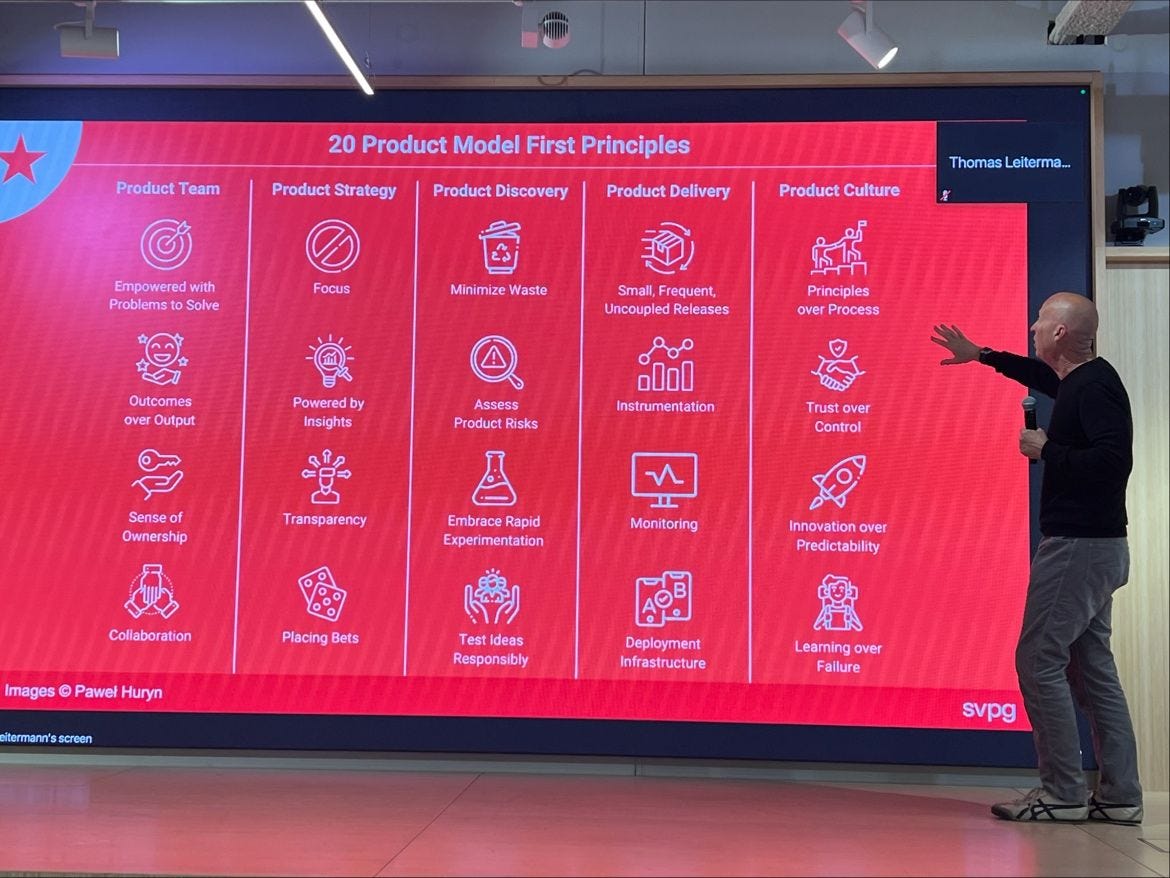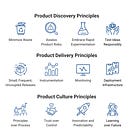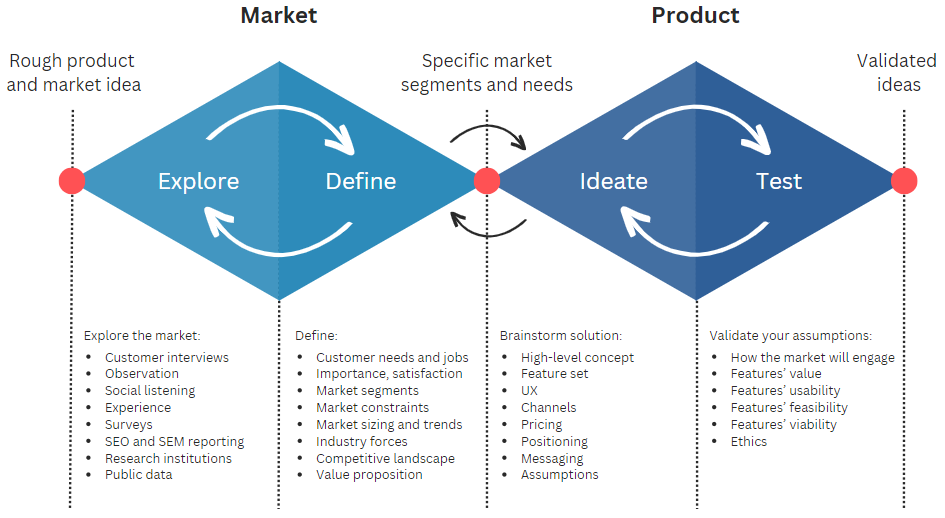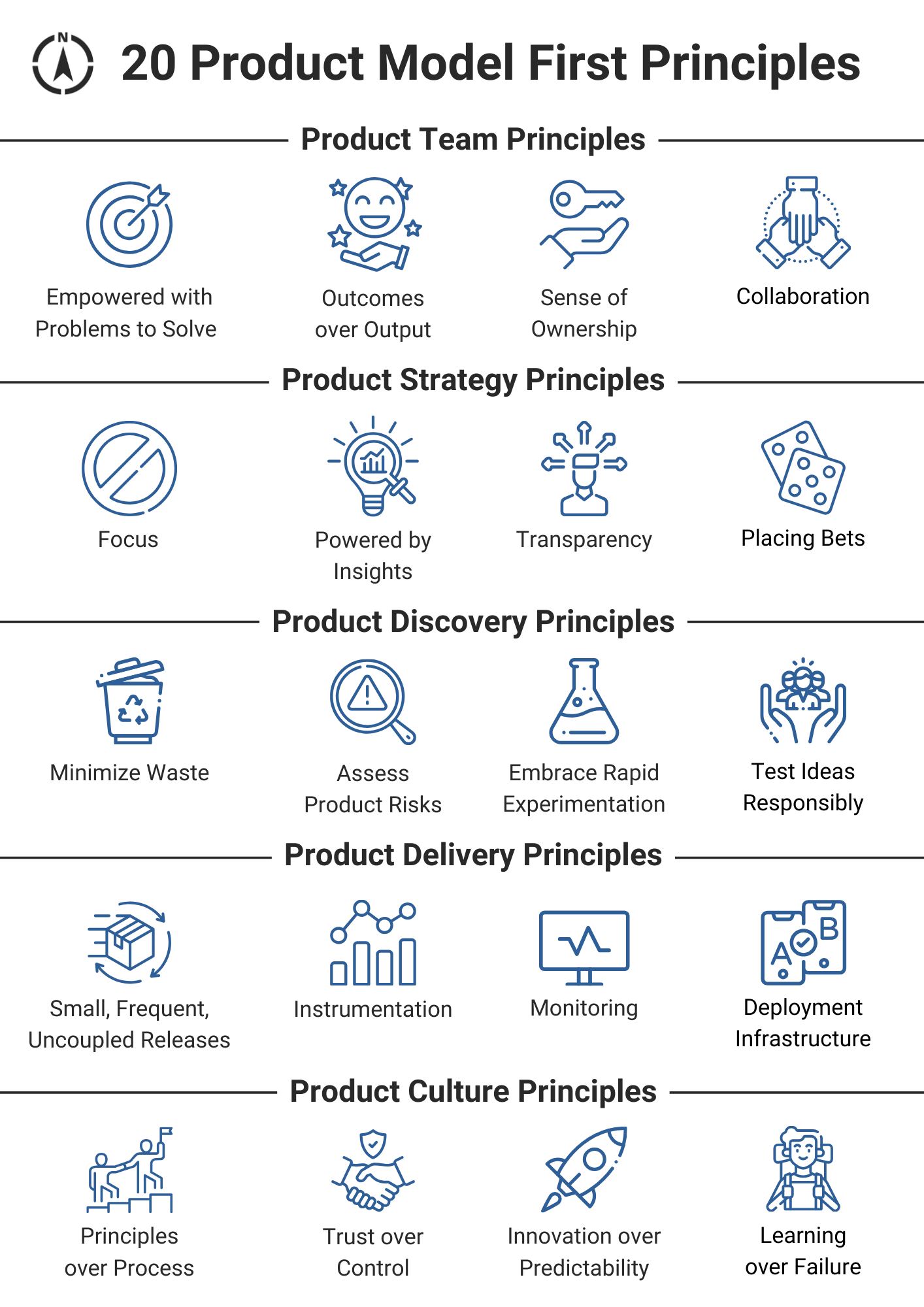Product Model First Principles: Product Team and Product Strategy In Depth
Product model first principles from TRANSFORMED. Part 1/2.
Hey, Paweł here. Welcome to a free edition of The Product Compass.
Every week, I share actionable tips and insights for PMs.
Here are some posts you might have missed:
Subscribe now, if you haven’t already, for the full experience:
Product Model First Principles: Product Team and Product Strategy In Depth
I finished reading Marty Cagan's TRANSFORMED.
It’s positioned as a book about moving to the Product Operating Model. But I realized it’s much more than just an excellent guide to transformation!
The book outlines 20 product model first principles shared by the best product companies in a way I didn't find in INSPIRED and EMPOWERED.
They can help you make better decisions, judge new techniques, build better products, and enjoy your job as a PM.
So, in today’s issue, I’d like to analyze and share my thoughts on two groups of principles:
Four Product Team Principles
Four Product Strategy Principles
BONUS: My questions to Marty Cagan answered
In the next part, on Thursday, we will discuss:
Four Product Discovery Principles
Four Product Delivery Principles
Four Product Culture Principles
[Edited] The next part:
💡 Product model first principles are described in Chapters 15-19 of TRANSFORMED. Every time I reference another chapter, I synthesize insights across the book.
1. Four Product Team Principles
“The most fundamental of all product concepts is the notion of an empowered, cross-functional product team” - Marty Cagan, TRANSFORMED
In his book, Marty presents the following product team principles:
Principle 1: Empowered with Problems to Solve
In his previous book, EMPOWERED, Marty defined an empowered product team as “given a problem to solve, rather than solutions to build, and, most importantly, are held accountable for the results.”
In TRANSFORMED (Chapter 8), he further defines two types of problems the team can be empowered with: customer problems and company problems and explains they are accompanied with desired outcomes to achieve.
Here, you might be a bit confused, as Teresa Torres calls those outcomes “product outcomes” and argues that “product outcomes measure human behavior.” While it’s often the case, I loved Marty’s generalization, as I’ve struggled with Teresa’s definition several times.
I noticed that many changes in human behavior lag behind metrics that are faster to read, like the Customer Effort Score (CES). In that case, influencing CES might be a better desired outcome.
As long as your team gets a set of desired outcomes you can directly influence, I encourage you not to obsess over whether those are “changes in human behavior.” Any other metric works just fine. All other aspects of Continuous Product Discovery and working with Opportunity Solution Tree are unaffected.
Team Objectives
Here, I need to explain another term Marty uses: team objectives (Chapter 13). At the beginning, I wasn't sure how they relate to problems.
In short, the team objective consists of:
A significant problem (as we already know, a customer problem or company problem).
Clear measures of success. Synonymous with desired outcomes mentioned earlier or key results.
If you use Objectives and Key Results:
The Objective is inspirational and explains the problem and why it matters.
Key Results are your desired outcomes to achieve.
Principle 2: Outcomes over Output
In product management, outcomes are the important results of your actions, not just the features you create. They are why you take action and can benefit your company or provide value to your customers.
We discussed different types of outcomes in Business outcomes vs. Product outcomes vs. Customer outcomes vs. Desired outcomes, which I updated to account for Marty’s generalization from the previous principle.
You can also read about the importance of having outcome-based roadmaps I recommended in the past (Marty also recommends them in Chapter 8).
Principle 3: Sense of Ownership
This principle is aligned with Simon Sinek’s:
Purpose: Why are we doing this? What’s our purpose? Why does it matter?
Autonomy: In No Rules Rules, Reed Hastings and Erin Meyer highlight the most critical aspect of Netflix's culture - leading with context, not control.
Critically, Marty explains that the team should be responsible for both coming up with the solutions to the problems (product discovery) and building and delivering the solutions to your customers (product delivery).
The same can be found in Team Topologies, in which Manuel Pais and Mattew Skeleton argue for the team-first approach, according to which each team should fully own a part of the product.
Principle 4: Collaboration
As Marty notices, collaboration doesn’t mean consensus or democracy.
In the past, I explained that team members should feel they have the right to be open and transparent, respectfully challenge others’ ideas, and explore diverse perspectives.
I love Amy Edmondson's book The Fearless Organization, in which she defines psychological safety as "a shared belief held by members of a team that the team is safe for interpersonal risk-taking."
In TRANSFORMED, Marty refers to one of Amazon’s leadership principles, “Have Backbone; Disagree and Commit,” in the context of a product team:
“Leaders are obligated to respectfully challenge decisions when they disagree, even when doing so is uncomfortable or exhausting. Leaders have conviction and are tenacious. They do not compromise for the sake of social cohesion. Once a decision is determined, they commit wholly.”
When talking about collaboration, Marty also emphasizes the importance of product discovery. Product managers, product designers, and engineers must work on it as a team, using their unique insights and experiences to come up with ideas and test them together.
We discussed it many times in the past. Here, you can read more about the Product Trio and how they collaborate.
2. Four Product Strategy Principles
Before we dive into product strategy principles, it’s essential to understand how Marty Cagan defines product vision and product strategy.
Product Vision:
In his past articles, Marty Cagan mentioned how people confuse empty mission slogans like “organize the world’s information” with a true product vision.
Product vision is much more. As Marty explains:
“The product vision the future you are trying to create and, most importantly, how this vision will improve the lives of your customers (…) product vision is what keeps teams inspired and excited.” - Marty Cagan, TRANSFORMED, Chapter 13
In Product Vision vs Strategy vs Objectives vs Roadmap, I suggested using a single term, product vision, quoting Prof. Roger Martin.
I’m happy that product mission is absent in the new book.
Product vision, as Marty defines it, perfectly aligns with people motivated by the purpose (Why) we discussed in The Product Leadership Playbook.
Product Strategy:
As Marty explains:
“The product strategy describes how you plan to accomplish the product vision, while meeting the needs of the business as you go (…) The output of product strategy is a set of business or customer problems to solve (team objectives)” - Marty Cagan, TRANSFORMED, Chapter 13
and:
“Product strategy is all about which problems are the most important to solve” - Marty Cagan, TRANSFORMED, Chapter 16
According to Marty, there is only one product strategy, and defining it is the ultimate responsibility of the product leaders (managers and leaders of product management, product design, and engineering).
Principle 5: Focus
When discussing this principle, Marty quotes Steve Jobs:
“People think focus means saying yes to the thing you've got to focus on. But that's not what it means at all. It means saying no to the hundred other good ideas that there are. You have to pick carefully. I'm actually as proud of the things we haven't done as the things I have done. Innovation is saying no to 1,000 things.” - Steve Jobs
This is perfectly aligned with the necessary trade-offs, as we defined in the Product Strategy Canvas:
“Trade-offs define what NOT to do. IKEA doesn't sell assembled furniture and limits available choices. Trade-offs create focus, amplify the value and make the product strategy difficult to copy by others without sacrificing their existing businesses.”
Principle 6: Powered by Insights
Insights power your strategy. While “insights can come from anywhere,” Marty lists four main sources:
Analyzing the data
Talking to your customers
New enabling technologies
The broader industry
In the past, in Your Guide to Crafting a Winning Product Strategy, I argued that “you can’t define strategy during a single workshop. Strategy is discovered, not just crafted. It requires many iterations” and that “you need to measure how your product is doing and whether the product strategy is working.”
In my opinion, discovering a product strategy for a new product is part of the Initial Product Discovery. It involves not just problems and ideas for solving them but also choices like sales channels, messaging, and pricing. All of them can be stated as hypotheses and validated.
You can apply similar techniques and sources of insights when reviewing product strategy for an existing product, particularly insights from product discovery. You will also be able to leverage product analytics.*
*See how Marty phrases product discovery as providing insights for product strategy in Q&A.
Principle 7: Transparency
In this principle, Marty emphasizes the importance of being transparent about data, reasoning behind your choices, and getting buy-in from stakeholders who might be impacted.
This might help you avoid “jealousy or frustration if stakeholders worry that the product leaders are pursuing their own interests and agendas” (Chapter 16).
While it’s not mentioned directly when discussing transparency, without transparency, it’s impossible to lead others with context, not control.
Just like when setting team objectives, people need to understand not only what strategic choices you made but also, more importantly, why you made them so they can make better autonomous decisions.
As Simon Sinek explains in Start with WHY, Why is the most important question a leader must answer.
Principle 8: Placing Bets
When discussing this principle, Marty emphasizes that strategy is not a science. There is no guarantee objectives you set will be met.
“If you have a critically important problem to solve, you might assign that problem to multiple product teams in the hope at least one of them will make a substantial progress in the quartet” - Marty Cagan, TRANSFORMED, Chapter 16
BONUS: My questions to Marty Cagan answered
I had some doubts related Product Team and Product Strategy principles, so I reached out to Marty and got explanations:
Question 1: Strategy vs. value proposition vs. team objectives
Paweł Huryn:
In Chapter 13, you argue that “The output of product strategy is a set of business or customer problems to solve (team objectives)”
At the same time, in Chapter 16, “Placing Bets” (which is about selecting customer or company problems to solve) is categorized as a “product strategy” principle.
I understand that product strategy involves, for example, value proposition(s). But it seems that it’s more broad and doesn’t have to include every specific team objective like “reduce churn by 10%.”
Is that correct?
Marty Cagan:
There's really two different concepts going on here when it comes to product strategy.
The first is deciding what the most important problems to solve are (that's the core of product strategy).
But the second, which is what placing bets is all about, is realizing that just because you assign a problem to a team does not mean they will succeed in solving it, at least in the next quarter. So instead we need to "play the odds" which might mean assigning the same problem to multiple teams, or maybe having one team focus on quick wins, and another going for a riskier but higher-potential solution.
Value proposition is a different thing, and is orthogonal to product strategy - it applies to product vision, product strategy and especially product discovery. It's your theory about why your product is going to be valuable to people. We test that at every level
Question 2: Strategic choices on different levels
Paweł Huryn:
“I’ve been reading the work of strategists like Prof. Roger Martin, who argues that while strategy is a singular, integrated set of choices, it has many levels (https://rogermartin.medium.com/strategic-choice-chartering-3d56d8962ec3)”
Marty Cagan:
“I had not seen this article, but I took a look at it and I like it, and it seems very consistent with what I was taught. But in the product world, we have names for the various layers he describes (and enumerated in the strategic context)”
Paweł Huryn (continued):
“Would you agree that Product Strategy stems from a general Business Strategy, especially if your company has many products?”
Marty Cagan (response continued):
“Absolutely. Business strategy drives go-to-market strategy and product strategy (in the book it describes the business strategy as the input to the product strategy, while problems to solve are the outputs), which in turn drives discovery strategy (not really a term we commonly use, but it's your approach to product discovery).”
Paweł Huryn (response continued):
“Also, I’ve been wondering what your opinion is on Product Managers contributing to their leaders' choices so that we can combine top-to-bottom and bottom-to-up decision-making. Those would be strategic insights product leaders get from their teams.”
Marty Cagan (response continued):
“Not only is this normal and good, but it is very common that learnings/insights in product discovery drive the next iteration of the product strategy. Insights drive product strategy, and many of the best insights come from the product teams (qualitatively and quantitatively).”
Paweł Huryn (continued):
“As I see it, this doesn’t challenge assumptions that Product Strategy is singular and that it’s the ultimate responsibility of the product leaders.”
Marty Cagan (response continued):
“I'm not positive what you mean by using the term "singular" regarding product strategy, but I do use the term "holistic" meaning it needs to look across all the related product teams.”
[Paweł Huryn: I explained later that I understand it the same, this is the term Prof. Roger Martin uses]
Thank you, Marty, for helping me and others understand these critical concepts!
Summary
So, what are the conclusions and the summary for today?
I wanted to share the product model first principles from TRANSFORMED before the book presents them in a way I didn't find in INSPIRED and EMPOWERED.
Those are the guiding principles that can help you make better decisions, judge new techniques, build better products, and enjoy your job as a PM.
I’m happy I didn’t find much difference between my content and TRANSFORMED, though I added a note in my post about different types of outcomes to account for business problems and customer problems, which I find to be a more useful, generic term.
In the next part, on Thursday, we will discuss:
Four Product Discovery Principles
Four Product Delivery Principles
Four Product Culture Principles
[Edited] The next part:
Bonus: Infographic
The official part of SVPG materials
Our graphics have become the official part of SVPG training materials:


Here, you can help me make this newsletter better:
P.S. Here you can watch our interview with Marty if you haven’t already:
Thanks for reading The Product Compass
It’s fantastic to learn and grow together.
Have a wonderful weekend and a fantastic week ahead!
Take care, Paweł









Great read, Pawel! Looking forward to see the entire interview seems like a treasure trove of product mindset and know how. Great intro to to book, added to the reading queue.
Thank you for the summary! I haven't gotten a chance to read the book, yet. But im looking forward to reading it; This summary will help me better digest and understand the full book.